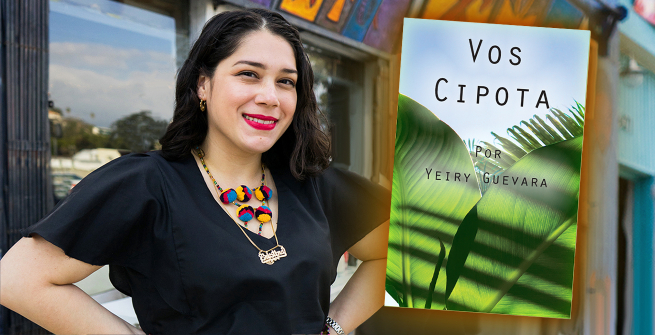Yeiry Guevara is a writer, translator, multimedia artist, and arts administrator. She has been published in Texas Monthly, VICE, and Remezcla with several gallery exhibitions in New York and Texas. She has also presented at the L.A. Times Festival of Books, L.A. Zine Fest, Columbia University, and Twitter Headquarters in NYC. After many years in New York, Yeiry currently lives in Houston, TX where she is the Grants Manager for Houston Arts Alliance, the City of Houston's designated local arts and culture agency.
How did you get interested in zines?
My first encounter with zines was through open call submissions. One summer, after creating work extensively in private, I felt ready to share my work on a public platform. I submitted my essay to a local zine and my photography to another one. To my surprise, I was accepted to both! This acceptance provided validation and confidence in my work. To see my work printed alongside other amazing artists, I was mesmerized by the power of paper. I accidentally made my first zine around this time too. I was preparing for my summer trip to El Salvador when my uncle asked me if he could read my work. Since he’s in a rural area and doesn’t have access to a computer, I designed a little booklet with my poetry and photography so he can read my work on paper. I shared this booklet titled “The Savior” with a few friends who encouraged me to put it on the internet. #CentralAmericanTwitter and the account, Central American Art @CentAm_Beauty, shared my work. After this post, my little zine took off with so many requests. I sent it out for free because I was excited to share my work with anyone who wanted to read. “The Savior” brought so much joy and connections.
What are your zines about?
As a first-generation Salvadoran, my creative work is based on healing and representation. This visibility is necessary due to the ancestral knowledge lost with migration. There is a profound need to own our narrative and document our history. I see my work as visible symbols of empowerment. This is why I create bilingual zines which explore memory, family, and intergenerational healing through the lens of photography and poetry.
What are some of your favorite zines and zine makers?
I have so many favorites! I highly recommend: St. Sucia, Barbara Calderón, Breena Nuñez, Kat Fajardo, Steph Guez, Eugenia Nicole, Margo Terc, Melissa Saenz Gordon, Jia Sung, La Liga Zine, Muchacha Fanzine, Cósmica, Chicle Zine, San Antonio Zine Fest, Puro Chingón Collective, La Horchata Zine. Many on this list have inspired me and encouraged my work in the zine world. Check them out!
Your zines are in our library collection for patrons to borrow. What do you think about that?
I am so honored to be in the LAPL collection! Libraries were a safe space for much of my childhood. I would escape in the endless stacks of books until closing time. I am so proud to have my work available to all patrons of the library. I hope my work is able to reach as many people as possible. If my work can spark one conversation between a kid and their parents or inspire one person to write their own story, that would be an incredible honor.
What do you think is the future of zines?
I see the future of zines as remaining true to its DIY ethics of self-publishing, where marginalized groups can own their voice on paper. This last year of a pandemic has really demonstrated the innovation and resilience of the creative economy. The biggest example of this resiliency is the evolution of Zine Festivals from in-person to virtual-only events. I see zines expanding into the digital realm in terms of increased distribution, funding for production costs, or as a place to learn about new artists. However, the digital realm could never replace the connections zines create in the physical realm. Zines have a sacred place in the creative economy. I hope cultural institutions will begin to view/include zines as a literary and creative medium that deserves the same amount of funding, respect, and value as other art disciplines. Much love to all the curators, librarians, professors, teachers who include zines in their collections, curated works, and lesson plans!
Why are zines important?
There is so much power in paper. The print media will never die. Even in a hyperconnected digital world, the tangible, physical encounter with paper is immeasurable. The combination of a xerox machine, pen, and a statement is astronomically powerful. Zines are so important for self-expression at any age! They’re empowering to make even if you have no idea what you’re doing. Zines are both a literary expression (write what you want!) and an artistic medium (collage, photography, illustration, up to you!). You can print what you want without waiting for validation, an acceptance letter, or approval. Go do the thing you want to see and let it live on paper. Additionally, I encourage you to go learn about new artists at your local zine festival, independent bookstores, or online through social media. Get inspired by all the amazing work that creatives are generating. Support your local creative economy and art makers!



